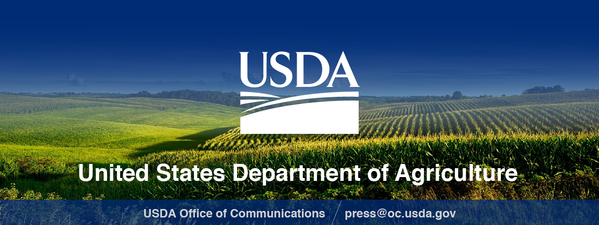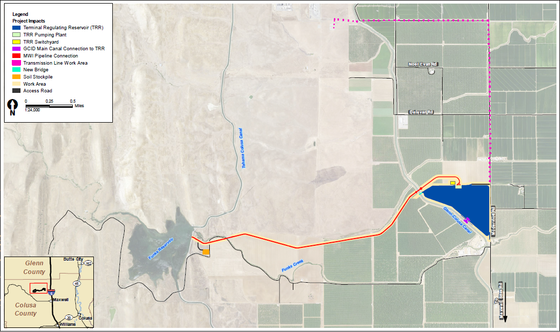Agriculture Secretary Sonny Perdue and Interior Secretary Ryan Zinke joined water leaders in the Sacramento Valley this week to help advance water supply reliability and multi-benefit water management in the region. This included a focus on the Maxwell Water Intertie described below—a project to help provide water management flexibility for the region.
The Maxwell Water Intertie will increase the efficiency and reliability of water management in the western Sacramento Valley by adding to and improving existing water infrastructure to facilitate greater flexibility in water conveyance, which would increase the drought resistance of rural communities and support the region’s agricultural economy. Importantly, the project will help serve water for multiple benefits in the Sacramento Valley, including water for the mosaic of farms, birds, fish, and recreation.
The project is described in more detail in the following release from USDA.
View as a webpage
(Maxwell, CA, November 27, 2018) – U.S. Secretary of Agriculture Sonny Perdue today announced the U.S. Department of Agriculture (USDA) is investing more than $449 million to help build an innovative water management system that will increase the reliability of the California water supply and create more than 560 jobs in the Sacramento Valley. Secretary Perdue was joined by U.S. Secretary of the Interior Ryan Zinke and Assistant Secretary of the Army for Civil Works Rickey “R.D.” James. The announcement follows on President Donald J. Trump’s memo to promote a reliable supply and delivery of water out west.
“Modern and reliable water infrastructure is the backbone to prosperity in the Sacramento Valley and across our nation. Under the leadership of President Trump, USDA is committed to being an ally to innovative leaders taking action to rebuild rural infrastructure in California and beyond, which is why we are investing in projects like the Maxwell Water Intertie,” said Secretary Perdue. “By working in a collaborative fashion with our state and local partners, we can balance the needs of everyone involved and ensure that the productivity of water in the Sacramento Valley is around for generations of farmers and ranchers to come.”
“Every westerner knows the saying ‘whiskey’s for drinking and water’s for fighting,’ but President Trump, Secretary Perdue and I are trying to make that obsolete. We all share a commitment to storing and delivering water for farmers, families and commercial users in California,” said Secretary Zinke. “In order to meet the demands of the future, we need to increase our storage capacity and bring our water infrastructure in to the 21st century. Large-scale water infrastructure projects, like the Maxwell Water Intertie and the Sites Reservoir projects which the Department partners on, will directly benefit from the nearly half-billion dollars that Secretary Perdue is making available.”
“The Army is committed to working with our federal, state and local partners to carefully manage the water resources of the Sacramento Valley,” said R.D. James, Assistant Secretary of the Army for Civil Works. “This project represents the President’s ongoing commitment to rural America to ensure the effective functioning of the nation’s agricultural economy.”
“The Maxwell Water Intertie will increase the efficiency and reliability of water management in the western Sacramento Valley by adding to and improving existing water infrastructure to facilitate greater flexibility in water conveyance, which would increase the drought resistance of rural communities and help to support our region’s agricultural economy.” said Jim Watson, General Manager, Sites Project Authority.
Background:
Made possible through USDA’s Community Facilities direct loan program, the Maxwell Water Intertie (MWI) facilities would connect the existing Tehama Colusa Canal (TC Canal) and the existing Glenn Colusa Irrigation District’s (GCID) main canal. These facilities would increase water management flexibility and improve water supply resiliency for participants during dry years and directly increase the efficiency and reliability of water management in the western Sacramento Valley.
The MWI includes the construction of 3 ½ miles of 12-foot diameter pipeline along with a new pump station that will be used to pump water from the GCID system to the existing Tehama-Colusa Canal Authority’s (TCCA) Funks Reservoir. Exchanges of water from Funks Reservoir to the GCID system will occur through the new pipeline by gravity flow in the reverse direction. The project also includes the construction of a new 1,200 acre-foot Terminal Regulating Reservoir (TRR) to be constructed adjacent to the GCID Main Canal that will help to regulate flows in the GCID main canal and support the operation of the Maxwell Water Intertie facilities. You may click on the images below to view larger maps online.
(You may click HERE or on the image above to view map online)
(You may click HERE or on the image above to view map online)
In April 2017, President Donald J. Trump established the Interagency Task Force on Agriculture and Rural Prosperity to identify legislative, regulatory and policy changes that could promote agriculture and prosperity in rural communities. In January 2018, Secretary Perdue presented the Task Force’s findings to President Trump. These findings included 31 recommendations to align the federal government with state, local and tribal governments to take advantage of opportunities that exist in rural America. Increasing investments in rural infrastructure is a key recommendation of the task force.
To view the report in its entirety, please view the Report to the President of the United States from the Task Force on Agriculture and Rural Prosperity (PDF, 5.4 MB). In addition, to view the categories of the recommendations, please view the Rural Prosperity infographic (PDF, 190 KB).
USDA Rural Development provides loans and grants to help expand economic opportunities and create jobs in rural areas. This assistance supports infrastructure improvements; business development; housing; community facilities such as schools, public safety and health care; and high-speed internet access in rural areas. For more information, visit www.rd.usda.gov.
###






